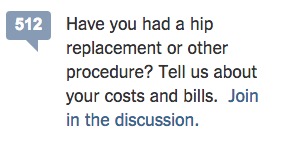In early 2013, New York Times health reporter Elisabeth Rosenthal wrote a story on the Times’ Well blog about the challenges of getting a quote for how much a hip replacement surgery would cost.
 In the sidebar of the story, the Times asked its readers: “Have you had a hip replacement or other procedure? Tell us about your costs and bills. Join the discussion.” That callout elicited 512 responses, and a whole database of potential sources for Rosenthal to use on future stories.
In the sidebar of the story, the Times asked its readers: “Have you had a hip replacement or other procedure? Tell us about your costs and bills. Join the discussion.” That callout elicited 512 responses, and a whole database of potential sources for Rosenthal to use on future stories.
Those sources became the foundation for Rosenthal’s ten-part series, “Paying Till it Hurts,” on the overwhelming costs of medical care. Today, the Times has a database of about 12,000 contributors and an active Facebook group that reporters can access.
Rosenthal’s use of crowdsourcing is one of the best practices highlighted in “Guide to Crowdsourcing,” a report out Friday from Columbia’s Tow Center for Digital Journalism.
In the report, authors Mimi Onuoha, Jeanne Pinder, and Jan Schaffer present a number of different ways journalists and news organizations can go about utilizing their readership and communities.
The report defines crowdsourcing as “the act of specifically inviting a group of people to participate in a reporting task — such as newsgathering, data collection, or analysis — through a targeted, open call for input; personal experiences; documents; or other contributions.”
While many publications will scour social media sites for stories (“Twitter reacts to X”), the report specifies that crowdsourcing requires direct engagement from newsrooms, and “the people engaging in crowdsourcing need to feel they have agency in contributing to a news story.”
The report lists six general ways outlets tend to crowdsource:
— Voting — prioritizing which stories reporters should tackle.
— Witnessing — sharing what you saw during a news event.
— Sharing personal experiences — telling what you know about your life experience.
— Tapping specialized expertise — contributing data or unique knowledge.
— Completing a task — volunteering time or skills to help create a news
— Engaging audiences — joining in call-outs that can range from informative to playful.
Outlets such as ProPublica, WNYC, and The Guardian have thoroughly integrated crowdsourcing into their newsroom operations. At other outlets, such as the Times and CNN, a smaller number of journalists have been specifically focused on crowdsourcing efforts.
Crowdsourcing can be used throughout the reporting process. The report highlights Jennifer Brandel’s work with Curious City at WBEZ in Chicago and now at her startup Hearken, which invites audience members to suggest and vote on stories to cover.Regardless of the crowdsourcing method a news organization chooses to use, the report notes that the best crowdsourcing campaigns “are high-touch, labor-intensive efforts.” Despite that effort, though, the report says that when it’s done well, crowdsourcing allows news organizations to interact with readers in ways that were impossible before the Internet.
Our research shows that crowdsourcing has been credited with helping to create amazing acts of journalism. It has transformed newsgathering by opening up unprecedented opportunities for attracting sources with new voices and information, allowed news organizations to unlock stories that otherwise might not have surfaced, and created opportunities for them to experiment with the possibilities of engagement just for the fun of it.
The full report is available here.
One comment:
Thoughtful blog post – I Appreciate the facts – Does someone know where my
assistant could grab a fillable KY Hart-Supported Lliving Grant
Application version to work with ?
Trackbacks:
Leave a comment
You must be logged in to post a comment.